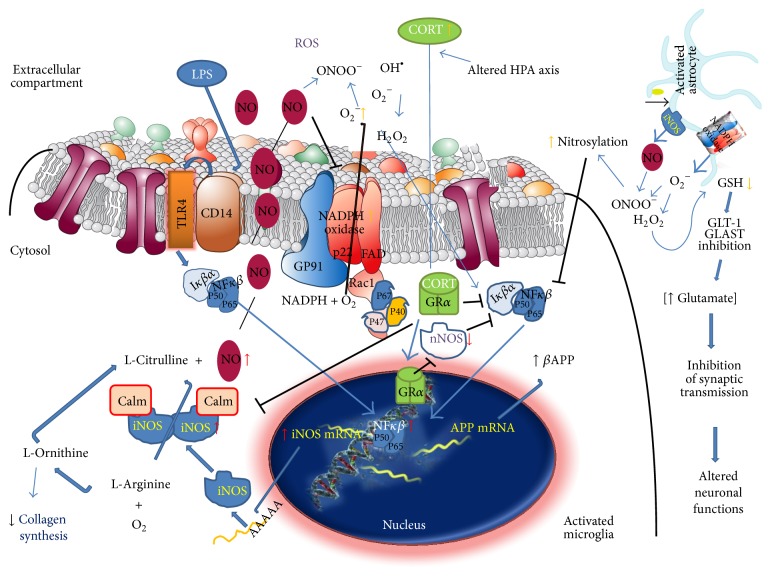Figure 7.
Glucocorticoids (Cortisol/Corticosterone) act as a nNOS inhibitor, and both molecules induce the releases of the NF-κB transcription factor that translocate to the nucleus to activate the synthesis of iNOS. Also other extracellular signals, such as lipopolysaccharide, act to induce NO production. NO acts as neurotransmitter and neuromodulator that regulates the NMDA receptors in the nervous systems. nNOS production of NO in CNS is associated with pain perception, control of sleep, appetite, thermoregulation, neural development, and synaptic plasticity. Activated microglia secrete inflammatory mediators to coactivate astrocytes and to induce cellular damage, which in turn will lead to abnormal synaptic transmission and neuronal dysfunction. NO antagonises NADPH oxidase (NOX2) assembly that in turn leads to a reduction in ROS production. Thus, as NO levels decline, oxidative mechanisms increase. Oxidative and nitrosative stress can also decrease intracellular GSH (reduced form) levels, resulting in a reduced antioxidant capability of the cells and an abnormal neuronal function. NO enhances glutamate release to influence memory processes by long-term potentiation (LTP). NO has been suggested as the retrograde molecule that activates the glutamate release. A compensatory mechanism, involving nNOS, is present in order to maintain LTP. The effect of NO on glutamate release depends on the NO level. Thus, when NO concentrations are low there is a decrease in glutamate release, but when NO increases, the inhibitory effect on glutamate release is reversed. S-Nitrosylation is a posttranslational regulatory mechanism that reduces the activity of target proteins, such as ERK, GAPDH, caspases, transglutaminases, and GTPase proteins (p21, RAC1, or cdc42). It has also been demonstrated that NO can induce S-nitrosylation and downregulate the NMDA receptor. S-Nitrosylation inhibits NF-κB, which could be an autoregulatory mechanism of NO production, since iNOS is induced by this transcription factor. NMDA receptor activation leads to the activation of nNOS, which could play a protective role by S-nitrosylation of the NMDA receptor; this inhibitory mechanism is regulated in order to prevent toxic effects. However iNOS activation and NO overproduction have also been suggested as an activator of NMDA-dependent neurotoxicity. Also, NO synthesis is involved in collagen physiology leading to connective tissue abnormalities.

